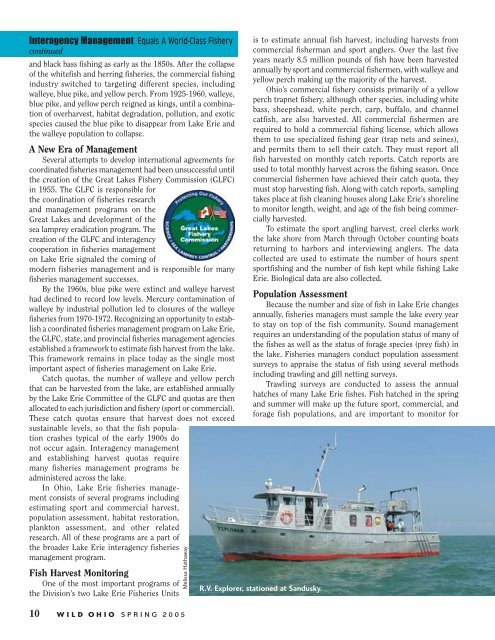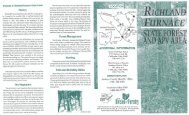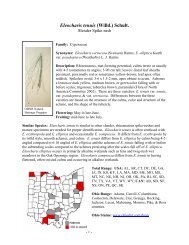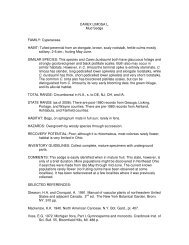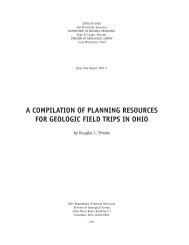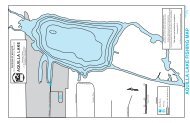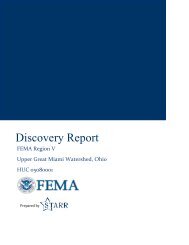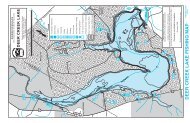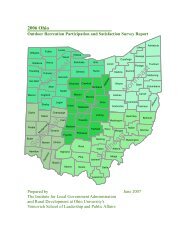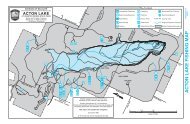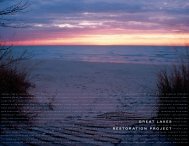special • lake erie • issue - Ohio Department of Natural Resources
special • lake erie • issue - Ohio Department of Natural Resources
special • lake erie • issue - Ohio Department of Natural Resources
You also want an ePaper? Increase the reach of your titles
YUMPU automatically turns print PDFs into web optimized ePapers that Google loves.
Interagency Management Equals A World-Class Fishery<br />
continued<br />
and black bass fishing as early as the 1850s. After the collapse<br />
<strong>of</strong> the whitefish and herring fish<strong>erie</strong>s, the commercial fishing<br />
industry switched to targeting different species, including<br />
walleye, blue pike, and yellow perch. From 1925-1960, walleye,<br />
blue pike, and yellow perch reigned as kings, until a combination<br />
<strong>of</strong> overharvest, habitat degradation, pollution, and exotic<br />
species caused the blue pike to disappear from Lake Erie and<br />
the walleye population to collapse.<br />
A New Era <strong>of</strong> Management<br />
Several attempts to develop international agreements for<br />
coordinated fish<strong>erie</strong>s management had been unsuccessful until<br />
the creation <strong>of</strong> the Great Lakes Fishery Commission (GLFC)<br />
in 1955. The GLFC is responsible for<br />
the coordination <strong>of</strong> fish<strong>erie</strong>s research<br />
and management programs on the<br />
Great Lakes and development <strong>of</strong> the<br />
sea lamprey eradication program. The<br />
creation <strong>of</strong> the GLFC and interagency<br />
cooperation in fish<strong>erie</strong>s management<br />
on Lake Erie signaled the coming <strong>of</strong><br />
modern fish<strong>erie</strong>s management and is responsible for many<br />
fish<strong>erie</strong>s management successes.<br />
By the 1960s, blue pike were extinct and walleye harvest<br />
had declined to record low levels. Mercury contamination <strong>of</strong><br />
walleye by industrial pollution led to closures <strong>of</strong> the walleye<br />
fish<strong>erie</strong>s from 1970-1972. Recognizing an opportunity to establish<br />
a coordinated fish<strong>erie</strong>s management program on Lake Erie,<br />
the GLFC, state, and provincial fish<strong>erie</strong>s management agencies<br />
established a framework to estimate fish harvest from the <strong>lake</strong>.<br />
This framework remains in place today as the single most<br />
important aspect <strong>of</strong> fish<strong>erie</strong>s management on Lake Erie.<br />
Catch quotas, the number <strong>of</strong> walleye and yellow perch<br />
that can be harvested from the <strong>lake</strong>, are established annually<br />
by the Lake Erie Committee <strong>of</strong> the GLFC and quotas are then<br />
allocated to each jurisdiction and fishery (sport or commercial).<br />
These catch quotas ensure that harvest does not exceed<br />
sustainable levels, so that the fish population<br />
crashes typical <strong>of</strong> the early 1900s do<br />
not occur again. Interagency management<br />
and establishing harvest quotas require<br />
many fish<strong>erie</strong>s management programs be<br />
administered across the <strong>lake</strong>.<br />
In <strong>Ohio</strong>, Lake Erie fish<strong>erie</strong>s management<br />
consists <strong>of</strong> several programs including<br />
estimating sport and commercial harvest,<br />
population assessment, habitat restoration,<br />
plankton assessment, and other related<br />
research. All <strong>of</strong> these programs are a part <strong>of</strong><br />
the broader Lake Erie interagency fish<strong>erie</strong>s<br />
management program.<br />
Fish Harvest Monitoring<br />
One <strong>of</strong> the most important programs <strong>of</strong><br />
the Division’s two Lake Erie Fish<strong>erie</strong>s Units<br />
10 WILD OHIO SPRING 2005<br />
Melissa Hathaway<br />
is to estimate annual fish harvest, including harvests from<br />
commercial fisherman and sport anglers. Over the last five<br />
years nearly 8.5 million pounds <strong>of</strong> fish have been harvested<br />
annually by sport and commercial fishermen, with walleye and<br />
yellow perch making up the majority <strong>of</strong> the harvest.<br />
<strong>Ohio</strong>’s commercial fishery consists primarily <strong>of</strong> a yellow<br />
perch trapnet fishery, although other species, including white<br />
bass, sheepshead, white perch, carp, buffalo, and channel<br />
catfish, are also harvested. All commercial fishermen are<br />
required to hold a commercial fishing license, which allows<br />
them to use <strong>special</strong>ized fishing gear (trap nets and seines),<br />
and permits them to sell their catch. They must report all<br />
fish harvested on monthly catch reports. Catch reports are<br />
used to total monthly harvest across the fishing season. Once<br />
commercial fishermen have achieved their catch quota, they<br />
must stop harvesting fish. Along with catch reports, sampling<br />
takes place at fish cleaning houses along Lake Erie’s shoreline<br />
to monitor length, weight, and age <strong>of</strong> the fish being commercially<br />
harvested.<br />
To estimate the sport angling harvest, creel clerks work<br />
the <strong>lake</strong> shore from March through October counting boats<br />
returning to harbors and interviewing anglers. The data<br />
collected are used to estimate the number <strong>of</strong> hours spent<br />
sportfishing and the number <strong>of</strong> fish kept while fishing Lake<br />
Erie. Biological data are also collected.<br />
Population Assessment<br />
Because the number and size <strong>of</strong> fish in Lake Erie changes<br />
annually, fish<strong>erie</strong>s managers must sample the <strong>lake</strong> every year<br />
to stay on top <strong>of</strong> the fish community. Sound management<br />
requires an understanding <strong>of</strong> the population status <strong>of</strong> many <strong>of</strong><br />
the fishes as well as the status <strong>of</strong> forage species (prey fish) in<br />
the <strong>lake</strong>. Fish<strong>erie</strong>s managers conduct population assessment<br />
surveys to appraise the status <strong>of</strong> fish using several methods<br />
including trawling and gill netting surveys.<br />
Trawling surveys are conducted to assess the annual<br />
hatches <strong>of</strong> many Lake Erie fishes. Fish hatched in the spring<br />
and summer will make up the future sport, commercial, and<br />
forage fish populations, and are important to monitor for<br />
R.V. Explorer, stationed at Sandusky.


